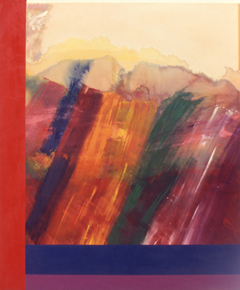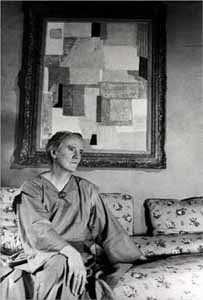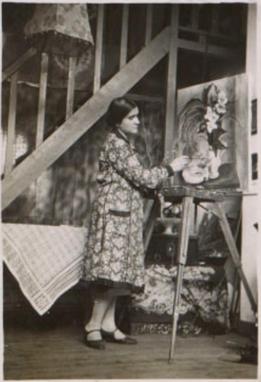
The Brooklyn Museum is an art museum located in the New York City borough of Brooklyn. At 560,000 square feet (52,000 m2), the museum is New York City's second largest and contains an art collection with around 500,000 objects. Located near the Prospect Heights, Crown Heights, Flatbush, and Park Slope neighborhoods of Brooklyn, the museum's Beaux-Arts building was designed by McKim, Mead & White.

Abraham Lincoln High School is a public high school located at 2800 Ocean Parkway, Brooklyn, New York under the jurisdiction of the New York City Department of Education. The school was built in 1929, and since graduated four Nobel Prize laureates, as well as many doctors, scientists, engineers, politicians, musicians, artists, and other notable alums. The current principal is Ari A. Hoogenboom.

Ronnie Landfield is an American abstract painter. During his early career from the mid-1960s through the 1970s his paintings were associated with Lyrical Abstraction, and he was represented by the David Whitney Gallery and the André Emmerich Gallery.
Albert Kotin belonged to the early generation of New York School Abstract Expressionist artists whose artistic innovation by the 1950s had been recognized across the Atlantic, including in Paris. The New York School Abstract Expressionism, represented by Jackson Pollock, Willem de Kooning, Franz Kline, and others became a leading art movement of the post-World War II era.

Peter Saul is an American painter. His work has connections with Pop Art, Surrealism, and Expressionism. His early use of pop culture cartoon references in the late 1950s and very early 1960s situates him as one of the fathers of the Pop Art movement. He realised about 800 paintings during his career.

Anne Ryan (1889–1954) was an American Abstract Expressionist artist associated with the New York School. Her first contact with the New York City avant-garde came in 1941 when she joined the Atelier 17, a famous printmaking workshop that the British artist Stanley William Hayter had established in Paris in the 1930s and then brought to New York when France fell to the Nazis. The great turning point in Ryan's development occurred after the war, in 1948. She was 57 years old when she saw the collages of Kurt Schwitters at the Rose Fried Gallery, in New York City, in 1948. She right away dedicated herself to this newly discovered medium. Since Anne Ryan was a poet, according to Deborah Solomon, in Kurt Schwitters’s collages “she recognized the visual equivalent of her sonnets – discrete images packed together in an extremely compressed space.” When six years later Ryan died, her work in this medium numbered over 400 pieces.
Anna P. Baker was a Canadian visual artist.
Joe Stefanelli, also known as Joseph J. Stefanelli, belonged to the New York School Abstract Expressionist artists whose influence and artistic innovation by the 1950s had been recognized around the world. New York School Abstract Expressionism, represented by Jackson Pollock, Willem de Kooning, Franz Kline and others became a leading art movement of the era that followed World War II. He died in September 2017 at the age of 96.
Calvert Coggeshall (1907-1990) was an abstract painter and a designer.

Ezio Martinelli was an American artist who belonged to the New York School Abstract Expressionist artists, a leading art movement of the post-World War II era.
The National Association of Women Artists, Inc. (NAWA) is a United States organization, founded in 1889 to gain recognition for professional women fine artists in an era when that field was strongly male-oriented. It sponsors exhibitions, awards and prizes, and organizes lectures and special events.

Birgitta Kathleen Moran Farmer was an American artist particularly known for her portrait miniatures.

Karl Knaths was an American artist whose personal approach to the Cubist aesthetic led him to create paintings which, while abstract, contained readily identifiable subjects. In addition to the Cubist painters, his work shows influence by Paul Cézanne, Wassily Kandinsky, Utagawa Kuniyoshi, Paul Klee, Stuart Davis, and Agnes Weinrich. It is nonetheless, in use of heavy line, rendering of depth, disciplined treatment of color, and architecture of planes, distinctly his own.

Lena Gurr (1897–1992), was an American artist who made paintings, prints, and drawings showing, as one critic said, "the joys and sorrows of everyday life." Another critic noted that her still lifes, city scenes, and depictions of vacation locales were imbued with "quiet humor," while her portrayal of slum-dwellers and the victims of warfare revealed a "ready sympathy" for victims of social injustice at home and of warfare abroad. During the course of her career Gurr's compositions retained emotional content as they evolved from a naturalistic to a semi-abstract cubist style. Discussing this trend, she once told an interviewer that as her work tended toward increasing abstraction she believed it nonetheless "must have some kind of human depth to it." Born into a Russian-Jewish immigrant family, she was the wife of Joseph Biel, also Russian-Jewish and an artist of similar genre and sensibility.

Adelaide Lawson was an American artist known for her modernist oil paintings of landscapes and figures. She was said to possess an ability to build surface harmony through the use of flat, shadowless forms of generalized color and to use distortion and silhouetted patterning so as to give observers a sense of animation and often amusement.

Daniel Celentano (1902–1980) was an American Scene artist who made realistic paintings of everyday life in New York, particularly within the Italian neighborhood of East Harlem where he lived. During the Great Depression he painted murals in the same style for the Section of Painting and Sculpture and the Federal Art Project.
Eugene Paul Ullman was an American Impressionist painter.

Nan Watson (1876–1966) was an American artist known for the flower paintings, portraits, and still lifes she made during the 1920s and 1930s. Showing frequently in group and solo exhibitions, she received praise for both the aesthetic and technical qualities of her work. Critics described her paintings as sincere, forthright, and direct and said they demonstrated good draftsmanship, harmonious composition, and fresh color values. In 1929, the art historian Lloyd Goodrich said, "One knows no other painter of flowers who captures so completely their delicate life without becoming in the least sentimental about it or lapsing into merely technical fireworks." In 1932, Edward Alden Jewell, the principal critic for the New York Times published a lengthy critique of one of her shows. In it, he wrote, "The field is thronged with artists who paint flowers; many of these artists are highly successful, though few are seen to arrive at the goal of superlative distinction. Among those who do attain this coveted goal, Nan Watson must certainly be numbered." At the same time, Margaret Breuning of the Evening Post wrote concerning the flower paintings, "It is the ability of the artist to give lyric transcription of natural forms in terms of design which imbues these canvases with their significance." Concerning Watson's portraits, Breuning noted a "surety of draftsmanship" and Watson's "fine perception that pierces to the essentials". Similarly, an unsigned review of 1928 said Watson succeeded in producing a "candor, directness, [and] fidelity to personal conceptions that one finds delightful in a world where there much conformity to standards of aesthetic performance from which the timid or the conventional may not deviate." This critic concluded, "Not only sensitive perception and technical skill are to be enjoyed in this engaging exhibition, but the revelation of personality that has gone into the making of each canvas."

Florence Ballin Cramer (1877–1971) was an American modernist artist known for her landscapes, still lifes, portraits, and nudes, each tending to have what one close observer called "a clearly expressed a mood or attitude as well as presenting an easily recognizable subject". Describing a retrospective exhibition in 1957, a curator said her paintings were "characterized by a pervasive impressionism which ranges from color-wrought realism to gentle abstraction." Augmenting her career as professional artist, Cramer established and directed an art gallery on 57th Street in Manhattan that was devoted to showing works by young artists and for many years she ran a shop in Woodstock, New York that sold antiques and books. During the early part of her adult life, she divided her time between Manhattan and Woodstock and later lived year-round in Woodstock. After her death, a friend, author Frank Leon Smith, said she had found in Woodstock "just the right place and at precisely the right time for her gifts and talents."
Mary Teichman is an American artist and printmaker known for her color aquatint etchings.














